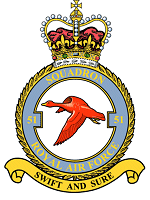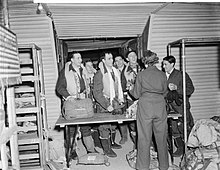No. 51 Squadron RAF
| No. 51 Squadron RAF | |
|---|---|
 | |
| Active | 15 May 1916 – 1 April 1918 (RFC) 1 April 1918 – 13 June 1919 (RAF) 5 March 1937 – 30 October 1950 21 August 1958 – present |
| Country | |
| Branch | |
| Type | Flying squadron |
| Role | Signals intelligence |
| Size | Three aircraft |
| Part of | No. 1 Group |
| Home station | RAF Waddington |
| Nickname(s) | 'York's own squadron' |
| Motto(s) | Swift and Sure[1] |
| Aircraft | Boeing RC-135W Airseeker |
| Battle honours |
|
| Insignia | |
| Squadron badge heraldry | A goose volant, chosen as a play on the word 'Anson', the aircraft which the squadron was flying when the badge was being designed, as 'Anser' is the Latin word for Goose, and it was felt that a heavy wild fowl was appropriate for a bomber squadron. Approved by King George VI in December 1937. |
| Squadron codes | UT (Aug 1939 – Sep 1939) MH (Sep 1939 – May 1945) LK (? – Jan 1944) ('C' Flt which became 578 Sqn) C6 (Jan 1944 – May 1945) ('C' Flt) TB (May 1945 – Dec 1949) MH (Dec 1949 – Oct 1950) |
Number 51 Squadron is a squadron of the Royal Air Force. Since 2014 it has operated the Boeing RC-135W Airseeker R.1, more commonly referred to as the Rivet Joint, from RAF Waddington, Lincolnshire.
It had previously flown the Hawker Siddeley Nimrod R.1 from 1974 until 2011.[2] Following the Nimrod's retirement, crews from No. 51 Squadron trained alongside the United States Air Force on the RC-135W Rivet Joint, which was being acquired by the RAF under the Airseeker project.[3][4][5]
History
World War I
51 Squadron
Interwar years
The squadron was reborn when 'B' Flight of 58 Squadron was renumbered as 51 Squadron at Driffield in March 1937, flying Virginias and Ansons. At this time the squadron badge was being chosen and a goose was chosen as a play on words: the squadron was flying the Anson and the Latin for goose is Anser. It was also appropriate for a bomber unit to have a heavy wild fowl to represent it.[7]
World War II


51 Squadron dropped
In February 1942, led by the legendary Percy Pickard, 51 Squadron carried 119 paratroops and an RAF flight sergeant skilled in electronics to Bruneval, France, in converted Whitleys. The men then carried out a very successful raid on a German radar installation, removing parts of a new type known as a Würzburg, which they took back to Britain.[9]
A brief period as part of
Postwar
The squadron became part of
The squadron again reformed in the 'Special Duties' role when

One of the three Nimrods on strength was retired at the end of November 2009
Aircraft operated
Aircraft operated have included:
- B.E.2
- B.E.12
- FE2b
- Martinsyde G.100
- Avro 504K
- Sopwith Camel
- Vickers Virginia Mk10
- Avro Anson Mk1
- Armstrong Whitworth Whitley Mk 2–5
- Handley Page Halifax Mk B2 and B3
- Short Stirling Mk5
- Avro York
- de Havilland Comet Mk2R
- English Electric Canberra B2
- Handley Page Hastings C1
- Hawker Siddeley Nimrod R1
- Boeing RC-135W Rivet Joint
See also
- Other Nimrod squadrons
- List of Royal Air Force aircraft squadrons
- No. 51 Squadron RAF Regiment
References
Notes
- ISBN 0-7100-9339-X.
- ^ a b "Nimrod R1 makes final flight" Archived 25 March 2012 at the Wayback Machine Defence Management Journal, 28 June 2011. Retrieved: 28 June 2011.
- ^ "Ministry of Defence – The Major Projects Report 2012 Appendix 3" (PDF). National Audit Office. 8 January 2013. p. 32. Archived from the original (PDF) on 19 December 2013.
- ^ "New RAF Intelligence Aircraft Arrives in UK Seven Months Early". www.defense-aerospace.com.
- ^ Perry, Dominic (12 November 2013). "PICTURES: First RAF Rivet Joint aircraft arrives in UK". Flight Global. Retrieved 18 December 2013.
- ^ "51 Squadron's War". Britain at War. Retrieved 29 June 2019.
- ^ Moyes 1976, p. 78.
- ^ "No. 51 Squadron RAF". Royal Air Force Museum. Retrieved 26 November 2020.
- ^ Price, Alfred. Instruments of Darkness: The History of Electronic Warfare, 1939–1945.Naval Institute Press; Revised, Expanded ed. (Aug. 1 2017)
- ^ "No. 51 Squadron (RAF): Second World War". History of War. Retrieved 29 June 2019.
- ^ Lake 2001, p. 130–131.
- ISBN 978-0007312665.
- ^ "UK squadron prepares for Nimrod R1 retirement". Flight Global. 18 February 2011. Retrieved 29 June 2019.
- ^ Peruzzi, Luca (20 May 2010). "RAF prepares for final Afghan deployment with Nimrod R1". Flight International. Retrieved 29 June 2019.
- ^ Hoyle, Craig (14 January 2011). "RAF personnel start Rivet Joint training". Flight International. Retrieved 29 June 2019.
- ^ Perry, Dominic (12 November 2013). "PICTURES: First RAF Rivet Joint aircraft arrives in UK". Flight International. Retrieved 29 June 2019.
- ^ Hoyle, Craig (21 July 2015). "RAF to take early delivery of UK's second Rivet Joint". Flight International. Retrieved 29 June 2019.
Bibliography
- Ford, Keith S. Snaith days: Life with 51 Squadron, 1942–45. Warrington, Cheshire, UK: Compaid Graphics, 1993. ISBN 0-9517965-1-8.
- Ford, Keith S. Swift and Sure: Eighty Years of 51 Squadron RAF (York's Own Squadron). Preston, Lancashire, UK: Compaid Graphics, 1997. ISBN 0-9517965-8-5.
- Forster, Dave; Gibson, Chris (2015). Listening In. Hikoki Publications. ISBN 978-190210938-1.
- Halley, James J. The Squadrons of the Royal Air Force and Commonwealth, 1918–1988. Tonbridge, Kent, UK: Air-Britai (Historians) Ltd., 1988. ISBN 0-85130-164-9.
- Lake, Jon. "Wyton's Cold War spyplanes: No 51 Squadron's Canberras". International Air Power Review. Volume 1, 2001. Norwalk, Connecticut, USA: AIRtime Publishing. pp. 130–137. ISBN 1-880588-33-1. ISSN 1473-9917.
- Moyes, Philip J.R. Bomber Squadrons of the RAF and Their Aircraft. London: Macdonald and Jane's (Publishers) Ltd., 1964 (Revised edition 1976). ISBN 0-354-01027-1
- Rawlings, John D.R. Coastal, Support and Special Squadrons of the RAF and Their Aircraft. London: Jane's Publishing Company Ltd., 1982. ISBN 0-7106-0187-5.
- Rawlings, John D.R. Fighter Squadrons of the RAF and Their Aircraft. London: Macdonald and Jane's (Publishers) Ltd., 1969 (Revised edition 1976, reprinted 1978). ISBN 0-354-01028-X.
- Ward, Chris. Royal Air Force Bomber Command Squadron Profiles, Number 16: 51 Squadron – Swift and Sure. Berkshire, UK: Ward Publishing, 1998.
